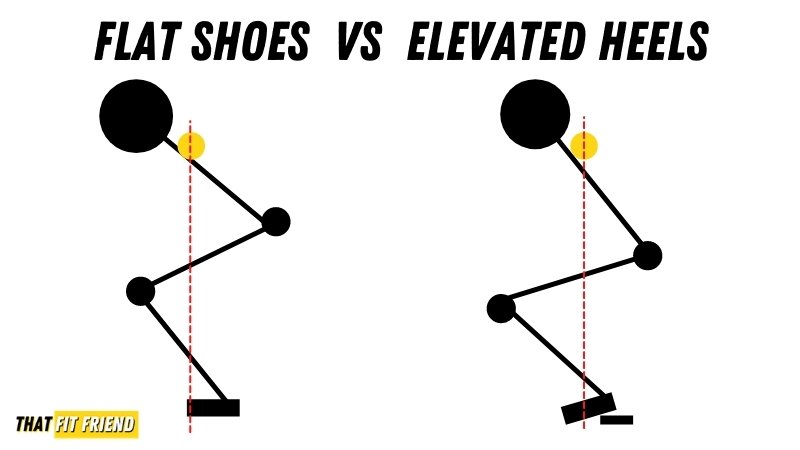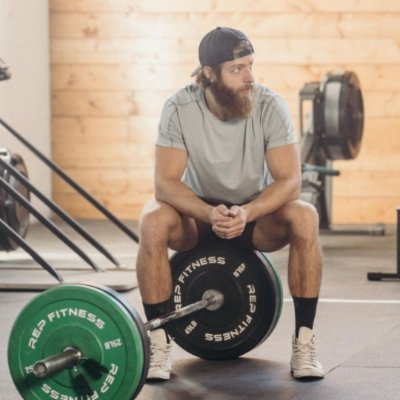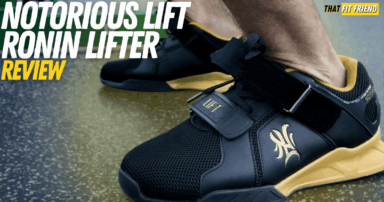On a daily basis, I’m constantly answering questions about weightlifting shoes and their pros and cons. In the context of training and supporting your goals, a weightlifting shoe can be an awesome tool depending on your needs.
Like with everything in the gym, there’s a lot of nuance that goes into choosing the right pair of weightlifting shoes for your needs. The pros and cons of weightlifting will ebb and flow based on your training.
In this article, I’ll cover some weightlifting shoe pros and cons to consider before buying your next or first pair. All of the pros and cons below are based on my coaching opinions and how I help other athletes select the right shoes for their goals.
Weightlifting shoes can be great for promoting stability when squatting and doing Olympic lifts, and they can be useful for teaching squat mechanics. That said, they’re not a bandaid for limited mobility and poor squat mechanics.
Table of Contents+
What Are Weightlifting Shoes?
Before we discuss the pros and cons of weightlifting shoes we should start by defining what weightlifting shoes are. There are a lot of key construction details that make weightlifting shoes unique in many ways.
Below are four key construction details that you can expect in every pair of weightlifting shoes. These features will give a weightlifting shoe a different feel and performance than something like a cross-training shoe.
Key Construction Details of Weightlifting Shoes
- Elevated Heel: Weightlifting shoes will have heel elevations that range from anywhere around .5 inches to 1 inch in height. This gives these shoes a heel-to-toe drop of 13mm-25mm, depending on the weightlifting shoe.
- Midfoot Straps: Weightlifting shoes will typically utilize a single or dual midfoot strap to promote additional upper security. This is a feature to help prevent the heel from popping out of your shoes when squatting, snatching, and clean & jerking.
- Dense Midsole: Weightlifting shoes will use materials like TPU, high-density EVA foam, stacked leather, or wood for their midsoles as these won’t compress and give you more ground feedback.
- Hard Rubber Outsole: Unlike training shoes that have more pliable rubber outsoles, weightlifting shoes utilize denser rubbers for their outsoles to promote traction and stability.
When searching for new weightlifting shoes you’ll want to consider how the above features vary between models. For example, TPU and high-density EVA foam midsoles can feel a little different.
As you try more weightlifting shoes and experiment with different shoes, you’ll naturally start to learn what features you like and what you should go for. If you ever have questions about any of this always feel free to reach out to me.
Weightlifting Shoe Pros
I’m confident we could come up with countless weightlifting shoe pros, however, I think there are three big pros and benefits of weightlifting shoes that will carry over to most contexts.
Pro 1: Great for Supporting Squat Mechanics
The first pro and arguably biggest benefit of weightlifting shoes is that they can be great for supporting proper squat form and mechanics. If you find that you’re struggling with squats due to mobility issues then it may be worth exploring weightlifting shoes.
For example, if you find that your ankles are limiting your squat performance or like you’re hinging too far forward and can’t maintain an upright torso when squatting, you’ll want to explore weightlifting shoes.
The elevated heel on a weightlifting shoe will allow our knees to translate more forward. This then allows lifters to sit into the hole of their squat a little more comfortably and balanced while being more vertical with their torso.
If you’re learning the squat and you’re struggling with balance, stability, and overall form, then exploring weightlifting shoes might be a good strategy call for your growth as a lifter.
Basically, using weightlifting shoes to help you learn stronger mechanics and feel more confident when squatting will positively affect your squat performance in general.
Keep in mind that weightlifting shoes are NOT a bandaid for poor squat form, but they can be a tool to help assist you in moving toward stronger squat mechanics and learning how to sequence your body efficiently.
Pro 2: Useful for Strength Sports Like Weightlifting and Powerlifting
Weightlifting shoes are also useful for strength sports athletes, and more specifically, athletes who plan or already compete in weightlifting, powerlifting, and CrossFit.
Weightlifting shoes are a must for weightlifters. In both the snatch and clean and jerk, catch positioning is everything, and weightlifting shoes can promote better and more balanced mechanics.
Why is this? The elevated heel in weightlifting shoes will help you catch weight with a more vertical torso which typically translates to stronger lifts and fewer missed lifts at that.
For powerlifting, weightlifting shoes can be hit or miss depending on your squat style and what promotes stronger squat mechanics. For this sport, you’ll typically only wear weightlifting shoes for the squat (some lifters wear them for bench press, but that’s for another article).
If you’re a powerlifter, then you’ll want to consider if you squat with a more low-bar, high-bar, or hybrid-like position. Your bar position, anatomy, and squat mechanics will influence whether you should use flat shoes or weightlifting shoes.
In the context of CrossFit, I typically recommend CrossFit athletes invest in a pair of weightlifting shoes even if they’re not planning to be competitive with the sport of CrossFit. They can be beneficial for most CrossFit athletes.
Since CrossFit workouts vary, I think it’s a good idea to bring a pair of weightlifting shoes with you to your WODs because you can then put them on for workouts that include snatches, clean & jerks, and heavier squat work.
Pro 3: Awesome for Tackling Different Training Goals
When most athletes and lifters think about weightlifting shoes, their minds go straight to squats and Olympic lifts. While these are obviously the contexts where most wear these shoes they’re not the only times they can be useful.
To expand here, I love how weightlifting shoes can add versatility to other exercises when your goals and needs are specific. This is also why I think it’s a good idea to invest in a pair of weightlifting shoes to keep in your lifting toolbox.
- Scenario 1: You’re performing split squats and want to promote a bigger quad bias. In this case, you can use weightlifting shoes to promote further knee tracking to accomplish your quad-focused goals.
- Scenario 2: You want to bias the quads on a pendulum squat, hack squat, leg press, or you find that these machines don’t align with your anatomy. In these cases, it might be worth exploring weightlifting shoes to help you accomplish the form and goals you’re after.
These are only a couple of instances where a weightlifting shoe’s performance can transcend squats and Olympic lifts. Think of weightlifting shoes as a tool, much like knee sleeves, there are contexts where they can make a lot of sense.
Weightlifting Shoe Cons
There are a lot of reasons to use and leverage weightlifting shoes for your growth in the gym. However, there are a couple of drawbacks to weightlifting shoes to keep in mind.
Con 1: May Be Excessive and Too Specific for Some Lifters
The first con that comes with weightlifting shoes is that they may not be a necessary buy for some lifters and they can be expensive. I tend to lean on the side that everyone should have a pair of weightlifting shoes, but there are some cases where you don’t need them.
For example, if you’re just doing general strength training and you have no desire to barbell back squat, work your Olympic lifts, or get super specific with your mechanics on accessories and machines, then you can pass on buying weightlifting shoes.
Most weightlifting shoes will cost at minimum $100 USD so if you’re strapped on a budget and not training in a means that would require this type of footwear, I’d pass on buying more shoes and save your money.
If the above sounds like you, I’d instead suggest investing in a good pair of cross-training shoes as this type of footwear will be much more generalist in nature.
Con 2: Can Mask Lacking Mechanics
I tread lightly with this weightlifting shoe con because it needs context, and weightlifting shoes alone won’t mask mechanics with your lifts. This con is alluding to lifters who only expose themselves to squats and exercises with weightlifting shoes on.
In my coaching opinion, I think it’s really important to expose yourself to training in different types of footwear as this will expose your feet and ankles to different types of stressors and ranges of motion.
If you’re constantly leaning on weightlifting shoes to make up for lacking mobility in your squat, for example, then you may want to try opting for barefoot or flat shoes or going barefoot for some accessories.
Doing this can be useful because it’s going to give you variability regarding how you move in different squatting-focused contexts. I think this can be important for not only gym performance but for real-world activities as well where you may be squatting and not wearing lifting shoes.
At the end of the day, the cons that revolve around weightlifting shoes stem from their cost and lack of programming consideration. If you’re not strapped on a budget and you’re being smart with their use there aren’t a ton of cons with this footwear.
What Does An Elevated Heel Do for Squats?
I’ve talked about how weightlifting shoes can influence lifting mechanics, but let’s dive into why an elevated heel can change how you’re sequencing your squats.
When you elevate the heel you’re putting the foot into a plantarflexed position which will then naturally allow the knees to translate further over the toes compared to if your foot was flat.
The elevated heel puts your knees into an environment that feeds more into forward knee translation. This is why it “feels” like you’re mobility increases with weightlifting shoes, however, in reality, you’re just changing the starting position of the ankles.
This is also why I think weightlifting shoes can actually be useful tools for assisting with mobility improvements because if you can access deeper ranges in squats while feeling stable and balanced, then there’s a good chance you’ll have carry-over to non-weightlifting shoe squats.
Again though, a weightlifting shoe’s elevated heel isn’t magically improving your mobility. It’s a tool that can assist with subtle and slow improvements over time and help with accessing deeper ranges of motion while feeling balanced.
Frequently Asked Questions (FAQ)
Q:Do weightlifting shoes really help?
Q:Are weightlifting shoes worth it for bodybuilding?
Q:Are weightlifting shoes and squat shoes the same?
Takeaway Thoughts
Weightlifting shoes can be awesome tools in the gym when it comes to supporting your performance. In most cases, weightlifting shoes come with a lot of pros and benefits.
They can be useful for building big squats, strength sports athletes, and as a tool for achieving specific goals on machines and with different accessory exercises.
If you have additional questions about weightlifting shoes or if you should bother investing in a pair, drop a comment below or reach out via Instagram (@jake_boly or @that_fit_friend).





















Add a Comment